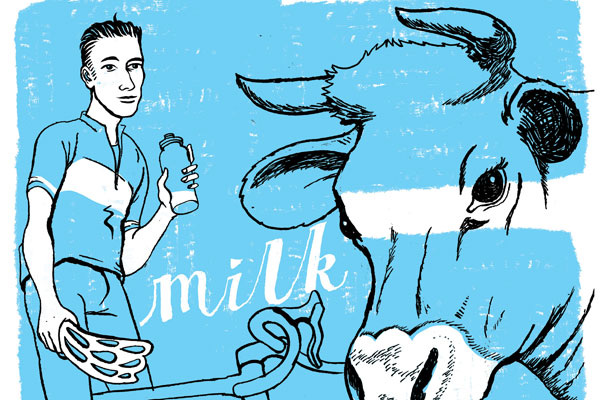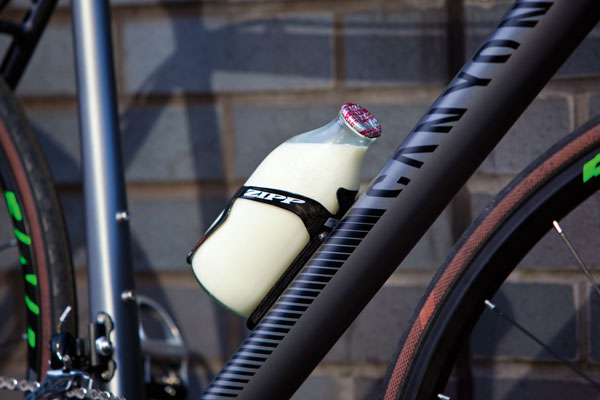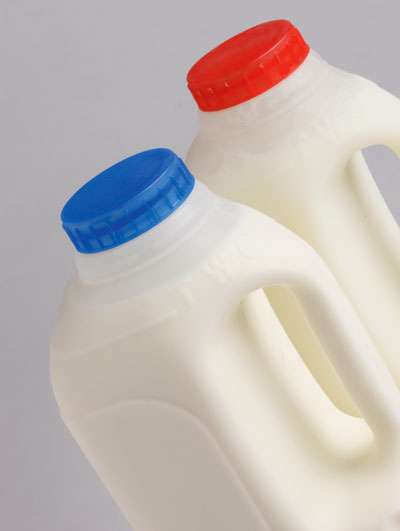How does milk affect athletic performace?

Olympic cyclist Laura Trott was seen last summer sporting a white milk moustache in a national ad campaign - but is milk really beneficial to sports performance, or is it just hype?
Described as the perfect re-hydration aid, milk has become something of a functional food in the sports nutrition world. At the other end of the scale, dairy foods are associated with digestive discomfort, headaches and respiratory problems. So, who's telling the truth? Should we be downing the white stuff or is it all just a clever marketing campaign?
Milk isn't the only dairy product to come under scrutiny. WADA, the World Anti-Doping Agency, has recently announced its new position on colostrums. Although the dairy product, taken from the milk of cows, has widely-touted health benefits and is used by a number of amateur and professional athletes, WADA is clarifying its position.
It states that the product may contain "quantities of IGF-1 and other growth factors which are prohibited and can influence the outcome of anti-doping tests. Therefore, WADA does not recommend the ingestion of this product."
The dairy herd
As the third-largest milk producer in the EU, the UK dairy industry has never been short of support, with a long list of poster campaigns and celebrity endorsements from ardent enthusiasts of milk and its by-products. Got milk? You betcha.
Despite negative press from the Paleo community and anti-milk campaign notmilk.com, we Brits remain steadfast fans of the white stuff, with average milk consumption per person in 2011 around one and a half litres a week - a figure that hasn't changed much in the last few years.
Get The Leadout Newsletter
The latest race content, interviews, features, reviews and expert buying guides, direct to your inbox!

Better than an energy Drink?
Research into the health benefits of dairy has also gained traction, with a growing interest in its potential as a recovery aid, a concept validated by the appearance of several high-profile Olympic athletes clutching bottles of chocolate milk as they left the track last year. No longer just a cereal companion, milk has been elevated to inexpensive recovery aid. So, do we all stand to benefit?
Dairy basics
Dairy foods have traditionally been promoted for their calcium content and associated bone health benefits. Processed into a variety of foodstuffs including cream, cheese, butter and yoghurt, more novel milk-based products such as whey, casein and colostrum powders have become increasingly popular as dietary supplements for both the recreational and elite athlete.
As a source of food for the young, milk is a nutritionally complete food containing a mix of carbohydrate, protein and fat. The main carbohydrate in milk is lactose, a double sugar composed of glucose and galactose, which requires the enzyme lactase for digestion.
Around 80 per cent of the protein in milk is casein, which forms a gel in the stomach, providing a slow release of amino acids over several hours.

The remaining 20 per cent is whey, the liquid portion of milk left over during the cheese-making process.

In contrast to casein, whey is a swiftly digested protein. It is this combination of fast - and slow - digesting proteins that is thought to give milk some of its unique properties as ‘performance nutrition' is concerned.
In addition to key macronutrients, milk provides minerals including calcium, potassium, sodium and phosphorous, all of which are dissolved in water-based fluid.
Dairy and sports performance
In recent years, milk has attracted interest as a potential hydration aid due to its naturally rich electrolyte and carbohydrate content.
- How does it work?
During exercise, fluid and electrolytes are lost in sweat, and must be replaced to prevent dehydration and the dips in performance. Research shows that fluid uptake in the small intestine is enhanced by the presence of glucose and sodium, both of which are found in milk in ideal quantities. In fact, milk has a sodium content similar to that of commercially prepared sports drinks, making it a viable alternative.
- What's the evidence?
In a 2008 study from the School of Sport and Exercise Sciences at Loughborough University, researchers pitted milk against a commercial sports drink on exercise performance in a small group of male volunteers.
Eight healthy subjects consumed 1.5ml of fluid per kilogram of body weight of either water, a carbohydrate-electrolyte drink, milk or milk with added glucose before starting exercise and then at 10-minute intervals during a set intensity protocol.
Results showed that both the milk and milk-with-glucose drink prolonged time to exhaustion as effectively as the sports beverage, without any changes to metabolic or thermoregulatory responses. Further studies have also found that the addition of milk protein to a carbohydrate solution aids re-hydration more effectively than carbohydrate-only drinks after exercise-induced dehydration.
- How can I benefit?
If you're riding for less than an hour, there's no need to use a specific hydration product, as water will suffice, but milk can benefit you as a re-hydration beverage in the recovery period. Some studies have found that milk contributes to feelings of fullness when taken as a fluid during prolonged exercise, although this has not been found to be detrimental to performance.
Recovery
The first 60 minutes after a ride is a unique window so far as recovery and nutrition are concerned. Carbohydrates are required to restock glycogen stores, while protein supports muscle repair and can accelerate glycogen re-synthesis, which boosts performance in subsequent training sessions. To benefit, a mix of both is required.
- Why does it work?
Milk contains both a blend of protein and carbohydrate, making it an inexpensive and effective recovery food. Research shows a 3:1 ratio of carbohydrate-to-protein is most effective for recovery, which can easily be found in the form of chocolate milk.
Providing around 50g of carbohydrate and 16g of protein per pint, chocolate milk also ticks off the necessary fluid requirement and provides more sodium than an equivalent volume of regular sports drink.
But it's not just the quantity of protein that makes milk an effective recovery aid. Milk protein is a blend of 20 per cent whey and 80 per cent casein. Casein is slow-digesting and provides a longer rise in amino acids, stimulating muscle protein synthesis over a prolonged period. Milk is also rich in branch chain amino acids that have been shown to have anabolic effects on muscles when consumed in the recovery period.
- What's the evidence?
Studies comparing consumption of milk versus carbohydrate drinks following resistance training show greater increases in lean muscle mass in milk drinkers.
Milk also stimulates muscle protein synthesis more effectively than soy beverages with the same protein and carbohydrate content, supporting the concept that the benefits are related to the mix of proteins and rate of digestion.
In a 2010 study from the University of Texas, 10 trained male and female cyclists were given chocolate milk, an isocaloric carbohydrate-only drink or placebo immediately after cycling for 1.5hr at 70 per cent of VO2max.
After a four-hour recovery period, the volunteers underwent a 40km time trial. Performance in the time trial was significantly shorter in the chocolate milk group compared to the carbohydrate or placebo groups. This finding has been supported in several subsequent studies, adding weight to the idea that chocolate milk is an effective recovery aid.
- How can I benefit?
Including 20g of dairy protein in your post-ride meal or snack may enhance recovery. 20g of protein can be found in 200g of cottage cheese, a scoop of whey protein, 200g of strained Greek yoghurt, or a pint of milk.
Weight loss
Milk and dairy foods habitually get the chop in weight loss diets due to their calorie and fat content, but evidence shows that this is a false economy, as dairy foods can actually support fat loss efforts.
- Why does it work?
The anti-obesity benefits of dairy are believed to be thanks to the role that calcium plays in body fat regulation.
Laboratory models show that low calcium intakes stimulate fatty acid deposition and suppress fat oxidation, promoting adiposity. Low-calcium diets are associated with higher rates of obesity, while high dairy diets are associated with greater reductions in body fat and weight loss under calorie-restricted conditions.
But it doesn't appear to be solely the work of the calcium, as supplementation doesn't provoke the same effects. As well as other bioactive compounds that may be responsible (such as branch chain amino acids), the protein-rich component of dairy foods can help to suppress hunger and limit loss of lean muscle mass when dieting.
- What's the evidence?
A number of studies have found that three or more servings of dairy foods each day can accelerate fat loss as part of a calorie-restricted diet.
In a 2012 meta-analysis of controlled clinical trials looking into dairy consumption and body weight in adults, researchers concluded that consumption of high-dairy weight loss diets led to significantly greater weight loss, reduction in body fat and waist circumference than control diets.
- How can I benefit?
If your goal is weight loss, creating an overall calorie deficit is still imperative, but adding three servings of dairy to your daily diet could boost your efforts. By consuming dairy foods after training, you'll also protect your lean muscle mass.
Dairy distress
Although there is plenty of evidence to support the benefits of dairy, some individuals can't tolerate dairy foods. The most common cause is lactose intolerance, an inability to digest lactose, the naturally occurring sugar in milk.
This occurs due to a deficiency of the enzyme lactase, which is needed to break lactose into single sugar units so that it can be absorbed. As a result, undigested lactose is transported to the large intestine, where it causes gas, bloating and diarrhoea.
Lactose intolerance is either genetic or temporary (eg after a stomach bug) but it can also develop with age, as we produce less lactase as we get older. Depending on the degree of lactose intolerance (which can range from mild to severe), most individuals can tolerate small amounts of lactose without discomfort.
Those suffering with irritable bowel syndrome may also struggle with digesting dairy, as they are more susceptible to lactose malabsorption. Those affected can opt for low-lactose alternatives or lactose-free milk, bearing in mind this will reduce the carbohydrate content. Butter and hard aged cheeses such as Parmesan are also naturally lower in lactose, as is Greek strained yoghurt.

What about other adverse effects?
Despite a lack of clear evidence or mechanism, there is a long-held belief that milk causes an increase in mucus production and respiratory discomfort. Team Sky chef Soren Kristiansen is known to use plant milks for those riders who experience upper respiratory congestion, and many athletes avoid milk for this reason.
Nevertheless, in a 2005 review published in the Journal of the American College of Nutrition, researchers were unable to detect any measurable mucus increase or secretions in milk drinkers suffering with the common cold. This has been a consistent finding in a number of other studies, including those involving asthmatics and respiratory disease.
Milk has also been associated with acne in studies of adolescents, which have shown a link between acne and total milk intake. Although not fully understood, this may be related to the impact of milk on insulin levels and insulin-like growth factor, which may stimulate acne in susceptible individuals. Interestingly, in one study from Harvard School of Public Health, the association with acne was more marked for skimmed milk.
To milk it or not?
Ultimately the decision of whether or not to include dairy comes down to personal choice. You can certainly survive without milk and milk products, and the nutrients they provide can readily be obtained from alternate sources (non-dairy sources of calcium include canned fish with bones, leafy green veg and dried fruit).
However, unless you have a specific reason to avoid dairy, it's worth considering the benefits. Not only do dairy foods make a convenient contribution to energy, carbohydrate and protein goals, their bioactive compounds also support recovery and improvements in body composition, which could just put you ahead of the game.
Supplement uncertainty - Colostrum
An increasingly popular supplement among athletes (including those from Team GB), colostrum is a form of bovine milk produced by cows in the first few days after birth. Sold as a powder, colostrum contains high levels of antibodies and immune-enhancing compounds.

A number of studies have shown it has the potential to benefit athletes by strengthening immune function and gut permeability, with additional interest in its benefits for lean body mass.
Although generally considered a safe supplement, the World Anti-Doping Agency (WADA) recently recommended that athletes adopt a safe approach and avoid the supplement due to the naturally high quantities of insulin-like growth factor 1 contained in colostrum, a substance on WADA's prohibited list.silver top shock
Full fat or skinny?
Since the 1980s, the main concern regarding dairy has been its fat content, with public bodies warning against the consumption of whole milk and full fat cheese due to a purported link between fat intake and heart health.
However, in a 2012 meta-analysis evaluating the evidence, researchers failed to find any convincing observational research linking dairy fat to heart disease risk or obesity risk. In fact, in 11 of 16 studies, high fat dairy intake was linked with lower body fat.
| 500g For Goodness Shakes Recovery Chocolate Milk | 315 | 17g | 52g |
| 1 pint semi-skimmed milk and 1 banana | 366 | 18g | 55g |
| 4 tbsp. Nesquick, 1 pint skimmed milk | 330 | 22g | 56g |
| 1 banana, 200g 2 per cent Total yoghurt, 30g honey | 349 | 20g | 60g |
This article was first published in the October 10 issue of Cycling Weekly. Read Cycling Weekly magazine on the day of release where ever you are in the world International digital edition, UK digital edition. And if you like us, rate us!

Thank you for reading 20 articles this month* Join now for unlimited access
Enjoy your first month for just £1 / $1 / €1
*Read 5 free articles per month without a subscription

Join now for unlimited access
Try first month for just £1 / $1 / €1
Founded in 1891, Cycling Weekly and its team of expert journalists brings cyclists in-depth reviews, extensive coverage of both professional and domestic racing, as well as fitness advice and 'brew a cuppa and put your feet up' features. Cycling Weekly serves its audience across a range of platforms, from good old-fashioned print to online journalism, and video.
-
 Man hands himself in to Belgian police after throwing full water bottle at Mathieu van der Poel during Paris-Roubaix
Man hands himself in to Belgian police after throwing full water bottle at Mathieu van der Poel during Paris-Roubaix30-year-old was on Templeuve-en-Pévèle cobbled sector when television pictures showed the bottle hitting him in the face
By Tom Thewlis Published
-
 Fizik Vento Omna Wide shoe review: Yeti sneakers for those pedalling on a budget
Fizik Vento Omna Wide shoe review: Yeti sneakers for those pedalling on a budgetBroadly recommended for those of us with flipper feet
By Simon Fellows Published